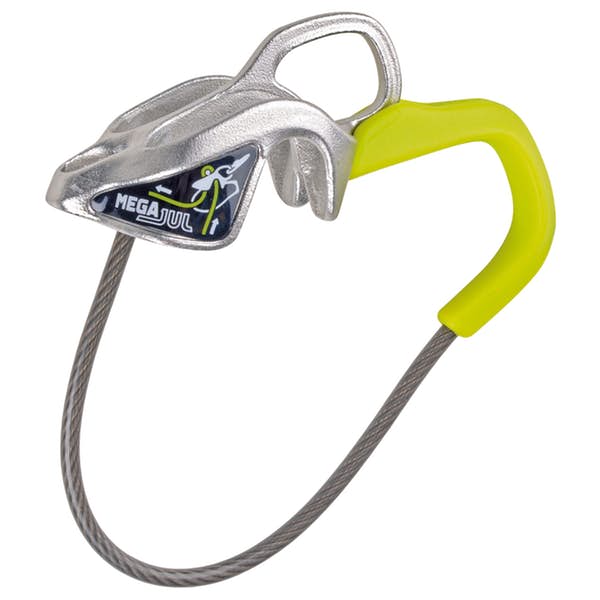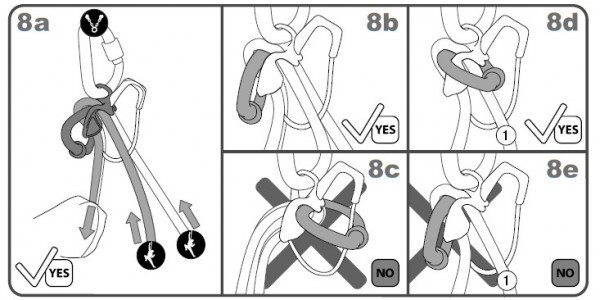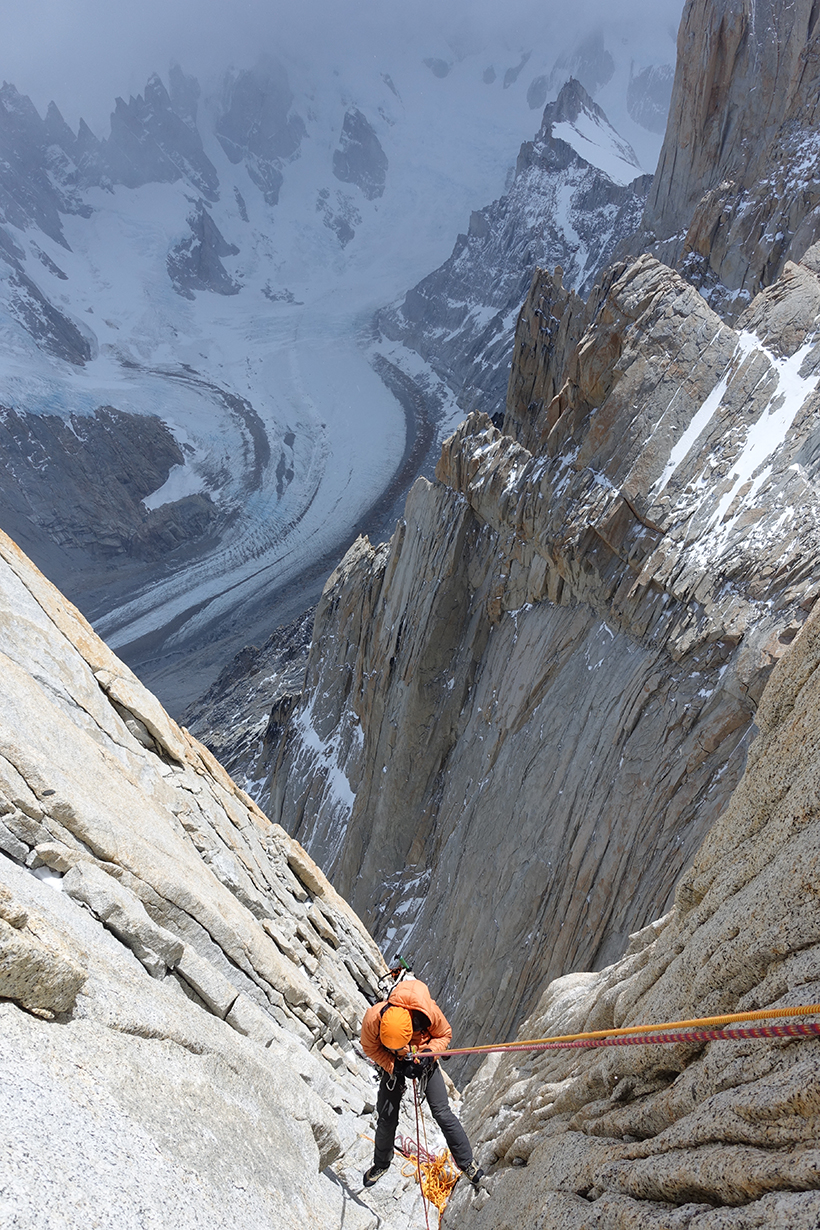
Edelrid Mega Jul Belay Device
Recommended Rope Diameter: 7.8-10.5 mm
Material: Stainless Steel
Stated Weight: 65 g / 2.3 oz
Measured Weight: 71.3 g / 2.5 oz
MSRP: $34.95
Test Locations: Black Canyon of the Gunnison NP, CO; Moab area, UT; Fitz Roy Massif, Argentina
Days tested: 30+
Intro
The Edelrid Mega Jul is one of a handful of new belay devices on the market that claims to combine a “passive assisted braking” function with the simplicity and low weight of a traditional tube-style device. This combination could benefit any climber looking for a lighter or safer belay device without the cost and weight of a Petzl Grigri.
I brought the Mega Jul with me as my primary belay device last fall and winter on climbs in the Black Canyon of the Gunnison, the Fitz Roy Massif of Patagonia, and a host of other areas in order to see if Edelrid had indeed produced the holy grail of belay devices.
*Note: The performance of any belay device will depend on the diameter of the climbing rope. I primarily used the Mega Jul with either a 9.4 mm single rope or a set of 8.5 mm twin ropes. I was happy with the performance of the Mega Jul when using these ropes, but still preferred using a Grigri 2 when climbing on a single rope in the 9.0-9.8mm range.
Design & Weight
The Mega Jul’s design is similar to a traditional tube-style belay device like the Black Diamond ATC-Guide or Petzl Reverso, but adds a thumb loop and notch in the body to enable the passive assisted-braking function. In “normal” use (belaying a leader or a top-rope in a slingshot configuration), the device loads just like a normal ATC, with the stipulation that the thumb loop points away from the belayer.
The Mega Jul I tested weighed in at 71.3 g, which puts it slightly above the stated weight of the Petzl Reverso (59 g / 2.1 oz), below the ATC-Guide (88 g / 3.1 oz), and at less than half the weight of the GriGri 2 (170 g / 6 oz).
Assisted Braking Mode
In its “normal” orientation with the thumb loop facing away from the belayer, the Mega Jul is set up to either belay a leader or a slingshot top-rope climber. When the rope comes tight, the rope sucks the belay carabiner up into the slot below the rope aperture (the opening you feed a bite of rope through when loading the belay device), then the device pivots slightly and pinches the rope between the carabiner and device, providing an extra level of friction in addition to the brake hand held below the device. In order to lower a climber, you must use your thumb in the thumb loop to lever the device back open — simply loosening your grip on the brake strand won’t do it.
While this mode is not auto-locking, I can feel a very distinct difference in the grip required to hold the brake strand when comparing the Mega Jul and a traditional tube-style belay device like the ATC-Guide. When using the Mega Jul in its “normal” orientation with either a single 9.4 mm rope or double 8.5 mm ropes, I found that I needed to apply significantly less force to my brake hand in order to catch a low-impact fall and hold a climber in place (compared to the ATC-Guide). That said, when using a single 9.0 mm rope with a dry-treatment (these coatings often make ropes a bit slicker), I found that the Mega Jul did not lock up as easily or as tightly as with a larger diameter, non-dry rope. In these instances, I found the required braking force was roughly equal between the Mega Jul and the ATC-Guide.

Giving slack to a leader while using the Mega Jul does take a bit more technique and finesse than is required with an ATC or Reverso, but I found that the motion was easy to learn and picked it up after only one or two pitches:
To quickly and smoothly feed slack, you hold the brake strand as you normally would on an ATC, but then hook your thumb through the large thumb loop on the Mega Jul. When feeding slack, you rotate your brake hand upwards so that your thumb pulls the device upwards and you can then feed out slack using your free hand. The one caveat here is that the Mega Jul will lock up easily if you try to feed slack quickly from an unruly pile of rope, so it’s even more important to make sure your rope is properly flaked when using the Mega Jul.
Guide mode
In my opinion, the biggest disadvantage of the Mega Jul is when it’s used in “guide mode” to belay a follower directly off the anchor. Not only is the proper orientation of the Mega Jul different from a normal guide-style device, the smaller rope aperture of the Mega Jul means there is significantly more friction when attempting to pull up slack — so much so that I’ve almost completely sworn off using the Mega Jul in this capacity, especially with ropes thicker than 9.4 mm. I also found that the amount of effort required to pull slack through was highly dependant on the belay carabiner used. I tested the Mega Jul with both a round-stock carabiner and an I-beam carabiner, and greatly preferred the round-stock as the rope fed smoother and locked down just the same.

*Note: When belaying a follower on a single rope in guide mode, make sure to clip the belay carabiner back through the keeper wire to ensure the rope cannot flip and unlock the device (see diagram above).
Rappelling
Initially, rappelling with the Mega Jul is also a bit of a hassle due to the range of potential orientations for the device. Although it is possible to rappel with the thumb loop oriented away from your body, doing so requires the climber to release the assisted locking feature similar to when lowering a climber on top-rope, and this can be pretty tiring, which is the last thing you want on a long descent.

Instead, Edelrid recommends rappelling with the thumb loop facing towards your body and using a third-hand back-up, such as a prusik or autoblock, instead of relying on the assisted braking function. In this recommended orientation, the device slides smoothly along the rope without the need to hold it open as you would have to with the thumb loop away from your body. Additionally, pointing the thumb loop at your body orients the device so that you can clip a carabiner through the guide mode hole to ascend the rope in an emergency.
Holding Power and Catching Hard Falls
Any belay device should easily hold a fall under a wide array of normal circumstances. While this is certainly true of the Mega Jul, catching high-impact falls with this device requires more work (in the form of holding the brake strand) than other devices like the ATC-Guide or Reverso.
In the case of catching a fall with the Mega Jul, the initial braking force is largely provided by the assisted braking function of the device — AKA the carabiner getting sucked up towards the rope aperture and pinching the rope. However, there is a limit to how much stopping power this passive braking mechanism can provide, and when more braking power is required — like in an unusually high impact fall — the remainder of braking power needs to be generated by the brake hand holding the rope in the locked position.
Because the rope aperture and carabiner on the Mega Jul don’t fully pinch down as much as they do in an ATC-Guide or Reverso, holding the rope with your brake hand requires a firmer hold on the rope to prevent slippage when catching hard falls with a Mega Jul.
This is mostly a side effect of the pivoting design of the Mega Jul; as the rope sucks the belay carabiner into the notch, the notch creates a limit as to how small and tight the rope aperture gets. Once the rope aperture reaches its minimum, the rope will continue to run through the device until the brake hand applies adequate force to stop the fall. Compare this to an ATC where braking power is increased since its lack of any notch lets the carabiner slide until it’s flush with the bottom of the rope aperture, which pinches the rope tighter and lets you hold the rope at a tighter angle, thus applying more friction through the device.
Additionally, the belay carabiner you use influences the amount of force necessary to hold a fall; a carabiner with a round cross-section (as opposed to an I-beam carabiner) provides more holding power as the carabiner has both greater surface area to provide friction and the wider cross-section pinches tighter in the rope aperture.
Durability
Although the Mega Jul is smaller and its metal thinner than the ATC-Guide or Reverso, I have not seen a dramatic difference in durability. This is likely due to the Mega Jul’s stainless steel construction, as opposed to the aluminum used on the ATC-Guide and Reverso. The steel on the Mega Jul hasn’t developed grooves around the rope aperture as quickly as the aluminum devices — I’ve seen an ATC-Guide wear out in as little as six months of consistent use (albeit in the highly abrasive environment of the Utah desert), but the Mega Jul shows no signs of sharpening across the rope aperture after 30+ days of use.
Who’s it For?
While the Mega Jul is a perfectly good belay device for a day of cragging, I think it really stands out on big routes where you want minimum weight but appreciate the extra security of the assisted braking capability.
From my experience, the Mega Jul seems best suited for a party of two attempting to move as quickly as possible on big routes. Here, my ideal belay system looks like a single Mega Jul paired with a standard tube-style belay device such as the Reverso or ATC (or, for greater weight savings, a single belay plate like the Camp OVO or Kong GiGi). At each pitch, the leader is belayed on the Mega Jul and belays the follower on the plate device. This combination gives both climbers the ability to rappel normally, and means that both the leader and follower are belayed on assisted braking devices for an added level of safety.
It’s also worth noting that Edelrid produces multiple variations of the Mega Jul design: the lighter and smaller Micro Jul that’s designed for twin and half ropes from 6.9–8.0 mm, the sport climbing-oriented Mega Jul Sport designed for 7.8–11.0 mm ropes, and the Jul2 — a single slot belay device with the same assisted braking function and rope specs as the Mega Jul Sport. Each of these variations share the similar passive assisted braking function, but are a bit more specialized for certain climbing disciplines.
Bottom Line
The Edelrid Mega Jul is an innovative belay device. When used properly and paired with an appropriate rope system, the Mega Jul offers good assisted braking capability in a lightweight package. However, the Mega Jul is certainly not the perfect all-around belay device, which is why I continue to use other belay devices for certain situations. As with any piece of equipment, it is imperative to fully understand the strengths and limitations of the Mega Jul. For most users looking for an assisted braking device for daily use with a single rope, I would still recommend the GriGri 2. However, the Mega Jul is a very good option for an experienced team looking to increase their margin of safety when moving quickly on big routes.
